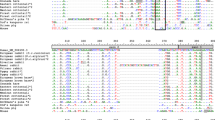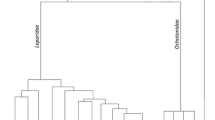Abstract
Whereas in its natural host (Sylvilagus sps.) the effects of myxoma virus infections are benign, in European rabbit (Oryctolagus cuniculus), it causes a highly infectious disease with very high mortality rate, known as myxomatosis. There is evidence that, as with HIV-1 virus in human, myxoma virus may use chemokine receptors such as CCR5 of the host target cell for entry and activation of pathways of immune avoidance. We have characterized and compared CCR5 genes of leporid species with different susceptibility levels to myxomatosis. The CCR5 protein of O. cuniculus differs markedly from all those known from other species. The most striking was the replacement of a specific peptide motif of the second extracellular loop (ECL2) by a motif, which in other species characterizes the CCR2 molecules. While absent in Sylvilagus and Lepus species, this CCR2 imposed CCR5–ECL2 alteration was observed in all genomes of 25 European rabbits, representing the subspecies O. cuniculus algirus and O. cuniculus cuniculus. Allelic variation at the rabbit CCR5 locus confirmed that the gene conversion predates the subspecies split (1–2 Ma).



Similar content being viewed by others
References
Barrett JW, Cao JX, Hota-Mitchell S, McFadden G (2001) Immunomodulatory proteins of myxoma virus. Semin Immunol 13:73–84
Best SM, Kerr PJ (2000) Coevolution of host and virus: the pathogenesis of virulent and attenuated of myxoma virus in resistant and susceptible European rabbits. Virology 267:36–48
Best SM, Collins SV, Kerr PJ (2000) Coevolution of host and virus: cellular localization of virus in myxoma virus infection of resistant and susceptible European rabbits. Virology 277:76–91
Branco M, Monnerot M, Ferrand N, Templeton AR (2002) Postglacial dispersal of the European rabbit (Oryctolagus cuniculus) on the Iberian peninsula reconstructed from nested clade and mismatch analyses of mitochondrial DNA genetic variation. Evolution 56:792–803
Callou C (1995) Modifications de l’aire de répartition du Lapin (Oryctolagus cuniculus) en France et en Espagne, du Pléistocène à l’époque actuelle. État de la question. Anthropozoologica 21:95–114
Cameron C, Hota-Mitchell S, Chen L, Barrett J, Cao JX, Macaulay C, Willer D, Evans D, McFadden G (1999) The complete DNA sequence of myxoma virus. Virology 264:298–318
D’Souza MP, Harden VA (1996) Chemokines and HIV-1 second receptors. Confluence of two fields generates optimism in AIDS research. Nat Med 2:1293–1300
Fenner F (1957) Myxomatosis in Australian wild rabbits; evolutionary changes in an infectious disease. Harvey Lect 53:25–55
Fenner F (1983) The Florey lecture, 1983. Biological control, as exemplified by smallpox eradication and myxomatosis. Proc R Soc Lond B Biol Sci 218:259–285
Fernandez EJ, Lolis E (2002) Structure, function and inhibition of chemokines. Annu Rev Pharmacol Toxicol 42:469–499
Ferrand N (1995) Variação genética de proteínas em populações de coelho (Oryctolagus cuniculus). Análise da diferenciação subespecífica, subestruturação, expansão geográfica e domesticação. Dissertação de Doutoramento, Universidade do Porto
França C (1913) Contribution à l’Étude du Lapin de Porto Santo. Bulletin de la Société Portugaise de Sciences Naturelles, Tome VI, Fasc. 2
Gerard C, Rollins BJ (2001) Chemokines and disease. Nat Immunol 2:108–115
Greber UF (2002) Signaling in viral entry. Cell Mol Life Sci 59:608–626 34
Guignard F, Combadiere C, Tiffany HL, Murphy PM (1998) Gene organization and promoter function for CC chemokine receptor 5 (CCR5). J Immunol 160:985–992
Hardy C, Callou C, Vigne JD, Casane D, Dennebouy N, Mounolou JC, Monnerot M (1995) Rabbit mitochondrial DNA diversity from prehistoric to modern times. J Mol Evol 40:227–237
Johnston JB, McFadden G (2003) Poxvirus Immunomodulatory Strategies: current perspectives. J Virol 77:6093–6100
Johnston JB, Barrett JW, Chang W, Chung CS, Zeng W, Masters J, Mann M, Wang F, Cao J, McFadden G (2003) Role of the serine-threonine kinase PAK-1 in myxoma virus replication. J Virol 77:5877–5888
Krug MS, Berger SL (1987) First-strand cDNA synthesis primed with oligo(dT). Methods Enzymol 152:316–325
Kumar S, Tamura K, Nei M (1994) MEGA: molecular evolutionary genetics analysis software for microcomputers. Comput Appl Biosci 10:189–191
Lalani AS, Masters J, Zeng W, Barrett J, Pannu R, Everett H, Arendt CW, McFadden G (1999) Use of chemokine receptors by poxviruses. Science 286(5446):1968–1971
Lopez-Martinez N (1989) Revisión sistemática y biostratigráfica de los Lagomorpha (Mammalia) del Terciario y Cuaternario de España. Diputación general de Aragón
Lu D, Yuan XJ, Evans RJ Jr, Pappas AT, Wang H, Su EW, Hamdouchi C, Venkataraman C (2005) Cloning and functional characterization of the rabbit C-C chemokine receptor 2. BMC Immunol 6:15
Mahalingam S, Karupiah G (2000) Modulation of chemokines by poxvirus infections. Curr Opin Immunol 12:409–412
Matthee CA, van Vuuren BJ, Bell D, Robinson TJ (2004) A molecular supermatrix of the rabbits and hares (Leporidae) allows for the identification of five intercontinental exchanges during the Miocene. Syst Biol 53:433–447
Masters J, Hinek AA, Uddin S, Platanias LC, Zeng W, McFadden G, Fish EN (2001) Poxvirus infection rapidly activates tyrosine kinase signal transduction. J Biol Chem 276:48371–48375
Mellado M, Rodriguez-Frade JM, Vila-Coro AJ, Fernandez S, Martin de Ana A, Jones DR, Toran JL, Martinez AC (2001) Chemokine receptor homo- or heterodimerization activates distinct signaling pathways. EMBO J 20:2497–2507
Mellado M, Martinez AC, Rodriguez-Frade JM (2002) Analysis of G-protein-coupled receptor dimerization following chemokine signaling. Methods 27:349–357
Monnerot M, Vigne JD, Biju-Duval C, Casane D, Callou C, Hardy C, Mougel F, Soriguer R, Dennebouy N, Mounolou JC (1994) Rabbit and man: genetic and historic approach. Genet Sel Evol 26:167–174
Murphy PM (1994) The molecular biology of leukocyte chemoattractant receptors. Annu Rev Immunol 12:593–633
Navenot JM, Wang ZX, Trent JO, Murray JL, Hu QX, DeLeeuw L, Moore PS, Chang Y, Peiper SC (2001) Molecular anatomy of CCR5 engagement by physiologic and viral chemokines and HIV-1 envelope glycoproteins: differences in primary structural requirements for RANTES, MIP-1 alpha, and vMIP-II Binding. J Mol Biol 313:1181–1193
Neote K, DiGregorio D, Mak J, Horuk R, Schall TJ (1993) Molecular cloning, functional expression, and signaling characteristics of a C-C chemokine receptor. Cell 72:415–425
Oppermann M (2004) Chemokine receptor CCR5: insights into structure, function, and regulation. Cell Signal 16:1201–1210
Regnery DC, JH Miller (1972) A myxoma virus epizootic in a brush rabbit population. J Wildl Dis 8:327–331
Ribeiro IP, Schrago CG, Soares EA, Pissinatti A, Seuanez HN, Russo CA, Tanuri A, Soares MA (2005) CCR5 chemokine receptor gene evolution in New World monkeys (Platyrrhini, Primates): implication on resistance to lentiviruses. Infect Genet Evol 5:271–280
Samson M, LaRosa G, Libert F, Paindavoine P, Detheux M, Vassart G, Parmentier M (1997) The second extracellular loop of CCR5 is the major determinant of ligand specificity. J Biol Chem 272:24934–24941
Seet BT, McCaughan CA, Handel TM, Mercer A, Brunetti C, McFadden G, Fleming SB (2003) Analysis of an orf virus chemokine-binding protein: Shifting ligand specificities among a family of poxvirus viroceptors. Proc Natl Acad Sci USA 100:15137–15142
Shields DC (2000) Gene conversion among chemokine receptors. Gene 246:239–245
Su C, Nei M (1999) Fifty-million-year-old polymorphism at an immunoglobulin variable region gene locus in the rabbit evolutionary lineage. Proc Natl Acad Sci USA 96:9710–9715
Thompson JD, Higgins DG, Gibson TJ (1994) CLUSTAL W: improving the sensitivity of progressive multiple sequence alignment through sequence weighting, positionspecific gap penalties and weight matrix choice. Nucleic Acids Res 22:4673–4680
Yamada F, Takaki M, Suzuki H (2002) Molecular phylogeny of Japanese Leporidae, the Amami rabbit Pentalagus furnessi, the Japanese hare Lepus brachyurus, and the mountain hare Lepus timidus, inferred from mitochondrial DNA sequences. Genes Genet Syst 77:107–116
Acknowledgements
We thank James Harris for editorial help. This work was supported by a Foundation for Science and Technology-Portugal project (POCI/BIA-BDE/61553/2004), by a grant of the Foundation for Science and Technology-Portugal (Praxis XXI/BPD/14551/2003) to P.E. and by a grant of the Belgian Fonds voor Wetenschappelijk Onderzoek Vlaanderen (Krediet 1.5579.98-FWOKN35) to W.vdL.
Author information
Authors and Affiliations
Corresponding author
Rights and permissions
About this article
Cite this article
Carmo, C.R., Esteves, P.J., Ferrand, N. et al. Genetic variation at chemokine receptor CCR5 in leporids: alteration at the 2nd extracellular domain by gene conversion with CCR2 in Oryctolagus, but not in Sylvilagus and Lepus species. Immunogenetics 58, 494–501 (2006). https://doi.org/10.1007/s00251-006-0095-4
Received:
Accepted:
Published:
Issue Date:
DOI: https://doi.org/10.1007/s00251-006-0095-4




